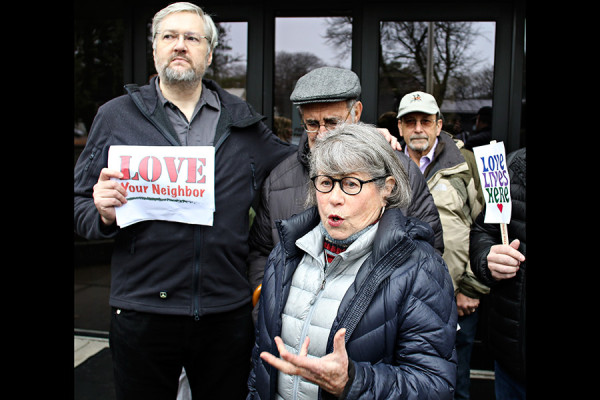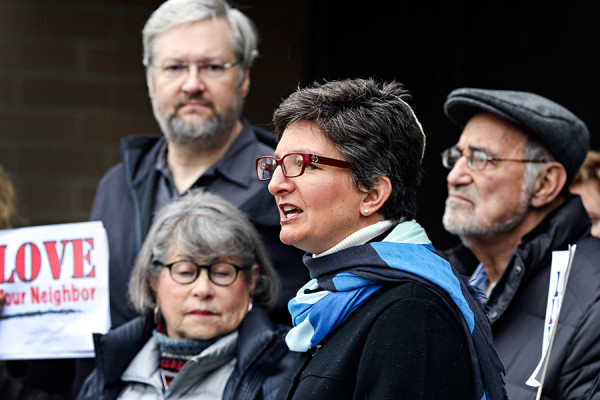A Dark Corner of the First Amendment
In Kalispell, a man’s threatening social media posts have been prosecuted under Montana’s felony criminal intimidation statute. As emotions surrounding the case run high, courts and advocacy groups across the country grapple with the gray area of free speech and online threats.
By Tristan Scott
In the broad context of social media networks that allow millions of words containing varying degrees of seriousness and violence to scuttle across the Internet every day, the hateful, threatening and violent epithets that David Joseph Lenio spewed forth into the online ethers from Kalispell last winter might have fallen on deaf ears.
But they didn’t.
Instead, a prominent gun control advocate and tech-savvy father from Maryland, with whom Lenio had tangled on the networking platform Twitter, uncovered a reservoir of violent threats directed at Jewish religious leaders and school children, among scores of other hate-filled posts, videos and images, and he turned them over to local authorities.
The question posed now by a Flathead County District Court case – a question with which numerous other state and appellate courts are wrestling in this brave new world of online speech protections – is whether the comments constitute criminal offenses.
In a tweet sent out Feb. 14, 2015, Lenio wrote: “This working and not having a g-d d-mn thing to show for it is bullsh-t makes me wanna execute grade #school #kids til the cops take me out too.”
In another post from the previous day, he stated: “Best way to counter the harm #jewish #politics is causing is #ChapelHillShooting styling killing of #jews til they get the hint & leave.”
In another, he writes of a desire to “put two in the head” of a rabbi, while hundreds of other examples highlight the rage and anti-Semitism of a radicalized Internet ideologue.

The Maryland man who discovered the tweets is Jonathan Hutson, who at the time worked as communications director for the Brady Campaign and Center to Prevent Gun Violence. From his home more than 2,000 miles away, he began monitoring Lenio’s online activity after a Twitter user responded to one of Hutson’s tweets linking to an article about the shootings in Copenhagen, Denmark, in which a filmmaker and a Jewish security guard were killed, the latter while acting as a volunteer security guard outside a synagogue.
Hutson was prepared to dismiss the Twitter user as a “garden variety Internet troll” – someone who engages in a kind of rampant Internet trash-talking – but after scrolling through previous tweets in which the poster discussed orchestrating school shootings, Hutson’s alarm bells rang louder; the tweets appeared genuinely threatening, and so he engaged the user, trying to draw out the intent of the person who was posting under the username PyschicDogTalk2, which Lenio launched after Twitter shut down his previous account.
When the user asked Hutson where his own children attended school, Hutson set to work unearthing a social media footprint that included hundreds of disturbing tweets, Facebook posts and YouTube videos. Initially believing that the author resided in Oregon – Lenio’s Twitter profile hinted at a former address from the state – Hutson culled the most offensive and threatening posts and called the Oregon FBI and Linn County Sheriff’s Office.
The Oregon authorities tracked Lenio’s IP address and found him in the Flathead Valley, and local authorities, including the Kalispell and Whitefish police, the Flathead County Sheriff’s Office and the FBI, arrested Lenio on Feb. 16, intercepting the 29-year-old man at the base of Big Mountain at Whitefish Mountain Resort, where he’d been snowboarding.
In an interview with local and federal law enforcement agencies, according to court records, Lenio acknowledged that he had sent the messages and said he was “trying to bring attention to certain social issues.” He asked whether his tweets had prompted any additional response by law enforcement, and told an officer he was glad his tweets were gaining the attention of law enforcement and school officials.
Kalispell Police Chief Roger Nasset called Lenio “a very real threat,” adding, “I did not want children’s blood on my hands because I didn’t do everything I could.”
Nasset said his department learned that Lenio had transported guns from a storage unit to his home, an act that elevated the threat to the next level and “gave him the opportunity and the means to carry out what he had been saying.”
The Flathead County Attorney’s Office charged Lenio with two felonies – criminal defamation, a charge that has since been dismissed as constitutionally overbroad, and intimidation, upon which the prosecution’s theory now rests.
Hutson, believing he may have thwarted a major act of violence, was pleased with his effort to root out Lenio from the dark recesses of the Internet and into the hands of authorities, and he has since kept a vigilant eye on the progress of the state’s case.
That progress came to a head earlier this month just days prior to Lenio’s scheduled trial, when public defender Brent Getty filed a motion to continue the proceedings on the basis that a plea deal was in the works and a resolution imminent.
Flathead District Judge Heidi Ulbricht agreed to postpone the trial until January while the attorneys worked toward a resolution. In response, Hutson and a group of local human rights activists and religious leaders convened Nov. 9 outside the courthouse in Kalispell to express their concerns that the charges against Lenio would be reduced or the prosecution deferred, urging the state to pursue its case against the man in earnest, and in full view of the public.

At the center of the legal dispute, however, is a question about whether Lenio’s posts, however upsetting to the community, constitute protected speech under the First Amendment.
The problem, legal experts say, is identifying what, exactly, counts as a true threat, a legal burden that First Amendment scholars and free speech advocates say is in place for a good reason, and probably deserves refining given the prominence of hateful online speech – its narrow standard requires that the government, in a country devoted to broad speech protections, prove beyond a reasonable doubt that a speaker intended to make a threat before it can put him behind bars.
Steve Freeman, legal affairs director for the Anti-Defamation League, which fights bigotry with a focus on anti-Semitism, said some types of speech are so dangerous that they do not deserve protection, and those true threats, or incitements of violence, are examples of that unprotected speech.
Online threats, however, have been more difficult to prosecute, particularly when there’s a question of whether threats that are not directed at a specific person, or at a group of people, are punishable “true threats.”
It is, Freeman said, a “tricky legal hurdle,” particularly in the context of social media, where body language and inflection are absent, and a recipient of the threat is not standing at arm’s length from the threatener.
“Where it gets tricky is that a criminal prosecution requires some level of intent beyond negligence and carelessness,” Freeman said. “Are you threatening certain people or just throwing it out into the ethers?”
In decisions dating back to 1969, the U.S. Supreme Court has already made it at least partly clear that the First Amendment does not permit the government to punish all threats made in communications in the media or in the public square. It has confined prosecution to “true threats,” and has stressed that the law against threatening someone does not apply at all to “political hyperbole” or to “vehement, caustic, or unpleasantly sharp attacks” that cannot be interpreted as ‘true threats.’”
As courts increasingly wade into the murky waters of online threats and noxious social media ranting, Freeman said each case would have to turn on its own merits, based on the facts alleged by the prosecution.
“The key may be whether there is targeting involved,” Freeman said. “If somebody is just expressing rage or hate, under our First Amendment you are free to engage in that speech. We don’t like it, it’s nasty, and a Jewish person like me is going to be offended, but it’s allowed. But if you are targeting somebody, and they as a reasonable person feel threatened, that is where the pendulum crosses the line. It’s the difference between expressing rage and expressing targeted rage, and it is the difference between protected speech and a criminal offense.”
Getty, the public defender representing Lenio, argues the former theory, saying the state’s intimidation statute requires that an actual person be involved, and that Lenio’s statements did not target an actual person.
“No alleged victim can be named, because there is no victim,” Getty wrote in his motion to dismiss. “Rather, the charging documents make only reference to ‘threats made on a social media service’ and that ‘an individual had been posting threats about killing kids on Twitter…’ Nowhere in the affidavit or the tweets is any specific kid, group of kids or school referenced.”
Getty filed the defense brief in May, and the following month Deputy Flathead County Attorney Stacy Bowman countered, both in a response to the defense motion and in an amended charging complaint that offered new evidence – five additional tweets discovered after a search warrant from Twitter was executed, and which mentioned a “Kalispell school.”
The tweets were all posted on Dec. 30, 2014 – shortly after authorities say Lenio arrived in the Flathead Valley and six weeks prior to his arrest – and they all convey a desire to carry out a mass shooting in a Kalispell school specifically.
“I David Lenio am literally so indebted & #underpaid that I want to go on a sandy hoax style spree in a Kalispell, MT elementary #school 2014,” reads one post, according to court records.
“Let’s make national news, I david lenio know Israel did 9/11 and I am so poor that I want to shoot up a Kalispell Montana public school,” says another.
Even before the Kalispell-centric tweets were discovered, authorities took the threat seriously, and some area schools that were open on Feb. 18, President’s Day, were put on a soft lockdown and extra officers were stationed nearby.
Most valley schools were not in session because of the holiday, including all of Kalispell’s public schools, but law enforcement notified school administrators that a general threat against schools had been made, according to Kalispell Superintendent Mark Flatau.
“At that point, the threat was certainly concerning but it was nebulous and general and incoherent. Police told us there should be more information as the day rolls along,” Flatau told the Beacon at the time.
Later that afternoon, more than 30 school administrators from around the valley met at the Kalispell School District Office and received a briefing from police, who informed them that Lenio was located at the ski resort and was being monitored.
That evening Flatau sent out a recorded message to over 5,800 families in the Kalispell school district informing them of the situation.
“I wanted to get the information out, even though it may be concerning,” he said.

It was through one of those phone calls that Rabbi Francine Roston, one of two practicing rabbis in the Flathead Valley, first learned of the threat.
Even before learning that Lenio’s tweets had mentioned shooting a rabbi, Roston said she perceived them as a true threat because law enforcement and the school system had responded.
“The police took it seriously, the community took it seriously, and I took it seriously,” Roston said. “I have two children in separate school districts in this valley. I am one of only two rabbis in this community. So if you say you are going to shoot up a school and put a bullet in the head of a rabbi, I take that seriously.”
Still, whether Lenio intended to that threat to be taken seriously is at issue.
Freeman, with the Anti-Defamation League, said it’s possible to shoulder the burden of proof in a true-threats case without climbing into the defendant’s mind and proving that he intended to carry out the threat; rather, a threat can be effectively prosecuted if the defendant intended it to be interpreted as a threat by a reasonable person.
“You can bring a prosecution without having to get into a person’s mind and prove that a person really intended to carry out the threat, but you have to be able to show that a reasonable person would interpret it as a real threat against them,” Freeman said. “As a Jewish person in New York where there are millions of other Jewish people, I still do not want to read about a person’s desire to kill Jewish people. But as a reasonable person, I probably would not interpret that as a direct true threat against me.”
Anthony Johnstone, a University of Montana School of Law professor who teaches federal and state constitutional law, said the new wave of online threats presents additional challenges for prosecutors and law enforcement, and he expects to see more of these cases rise to the Supreme Court on appeal.
“What makes these cases harder is the defendant is publishing the threat on something like Twitter or Facebook and not directly communicating to the intended victim,” Johnstone said. “So in order to meet the elements of the First Amendment exception the prosecutors have to connect some dots to show an intent that constitutes a true threat.”
Lee Rowland, senior staff attorney for the American Civil Liberties Union’s Speech, Privacy and Technology Project, said the rising prominence of speech in the digital world underscores the need to craft criminal laws narrowly so as to avoid promoting self-censorship and to weed out the speech that is indeed criminal.
Rowland and other advocates for civil liberties want to give more breathing room to free speech, and say the question of whether an online statement qualifies as a threat should not be “in the eye or ear of the beholder.”
“Even if the speech is nasty, racist, sexist, ad hominem, bigoted, that speech deserves First Amendment protection,” Rowland said. “Our position is that the true threat standard requires a subjective intent to do harm by the speaker. What it means is that you knowingly engage in speech that will cause fear or harm in someone else.”
In an online threats case the U.S. Supreme Court tackled in July, the court ultimately reversed the conviction of a Pennsylvania man who posted threats of domestic violence on Facebook after his wife left him. The case, Elonis v. United States, drew a flurry of “amicus briefs” – literally “friend of the court” briefs – from the ACLU and other groups who argued that the Supreme Court should require a higher bar for conviction.
“Words are slippery things, and one person’s opprobrium may be another’s threat,” the ACLU brief states.
“We don’t criminalize speech without that clear intent,” Rowland said.

In the case of Lenio, who in July was released to his family in Michigan on the condition that he refrain from using social media and the Internet, and that he obtain a mental health evaluation, whether or not he intended his tweets as a “true threat” can only be resolved by a jury at trial. It remains unclear whether the case will go to trial, and as of Nov. 16 no plea deal had been reached.
The case remains fluid, and in an article published Nov. 13 by a national blogger for the Southern Poverty Law Center, its author reported that Lenio had apparently violated the terms of his release by posting 348 “retweeted” messages from the Twitter username PsychicDogTalk3. The profile information states that “twitter suspended (deleted) my account again as if they don’t like my totally legal#FreeSpeech round 3.”
At the time this article went to print, the Flathead County Attorney’s Office had not filed any court briefs alleging that Lenio violated the conditions of his release, and it’s unclear whether they will (attorneys on both sides of the case declined to provide comment for this story).
It’s also not clear, legal experts say, whether appellate courts will ultimately have to tackle the broader First Amendment question of when seemingly threatening online messages constitute a crime, even when the intent to do harm seems obvious.
“What this all comes down to is that each case turns on its own facts. It’s not just what’s within the person’s mind, it’s what a reasonable person would take from it, and those are the relevant questions for a judge and jury,” Freeman said. “They might be difficult questions, but I am not upset that these cases are difficult to prove, that they have to show a narrow standard of intent, because they should have to show that.”